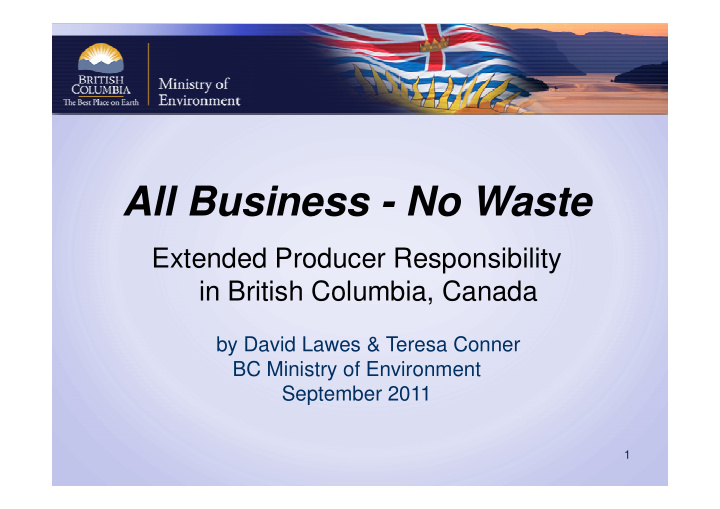



All Business - No Waste Extended Producer Responsibility Extended Producer Responsibility in British Columbia, Canada by David Lawes & Teresa Conner BC Ministry of Environment September 2011 1
British Columbia Facts • Population: 4.5 M • Half the population lives in Metro lives in Metro Vancouver • GDP $197.9 Billion • Top 3 exporting partners: – 1. U.S. (49.9%) – 2. Japan (13.6%) – 3. China (10.2%)
The problem with waste… • We make too much of it…. – Per capita waste generation increasing – Population increasing • Expensive to manage for local governments with very little influence over inflow • Long-term liability • Drain on the economy; expensive for businesses 4
“Change does not happen by consensus” happen by consensus”
“If you don’t like change - then you will like - then you will like irrelevance even less”
Consumers are changing…
More consumer change…
“…..brands often decline, not because they have lost their ability to deliver or the loyalty of their customers, but because customers, but because they have become less relevant. ”
More consumer change…
Extended Producer Responsibility in BC • BC Recycling Regulation - requires producers to • BC Recycling Regulation - requires producers to collect and recycle the products that they make and sell. • Provides producers with a financial incentive to make and sell products that : • are more durable , reusable and recyclable • contain less toxic material • never become waste .
Who is the Producer? Manufacturer Brand-Owner Importer Retailer 13
Current Programs 1. Paint (1994) 10. Batteries (2009) 2. Pesticides (1996) 11. Cell phones (2009) 3. Gasoline (1996) 12. Audio Visual (2010) 4. 4. Solvents and Solvents and 13. Thermostats (2010) 13. Thermostats (2010) flammable liquids 14. Fluorescent lamps (1996) (2010) 5. Pharmaceuticals 15. Car batteries (2011) (1996) 16. Smoke Detectors 6. Beverage Cont. (1997) (2011) 7. Lubricating Oil (2003) 17. Antifreeze (2011) 8. Tires (2007) 18. Small Appliances 9. TV’s, Computers (2007) (2011)
Upcoming Programs 1. Electric/electronic tools (July 2012) 2. 2. Automatic dispensers (July 2012) Automatic dispensers (July 2012) 3. Lighting Equipment (July 2012) 4. E-Toys (July 2012) 5. IT telecom. equipment (July 2012) 6. Monitoring/control Equip. (July 2012) 7. Packaging and Printed Paper (2014) 15
Benefits – as of 2008… Economic Impact of BC Recycling Regulation (2008) by Gardner Pinfold Consulting Economists - 2100 jobs created - Reduced landfill costs (short and long term) - Reduced GHG`s - 5.3 million gigajoules of energy saved each year - equivalent to 72,950 passenger cars removed from the roadway each year 16
Canada-wide Action Plan for EPR (2009) Provides all provinces and territories with a harmonized set of principles and a common schedule of products Phase 1 (by 2015) Phase 1 (by 2015) Phase 2 (by 2017) Phase 2 (by 2017) • packaging and printed materials, • construction and demolition materials • electronics and electrical • furniture, textiles and carpet • mercury-containing products (including lamps), • appliances (including ODS) • household hazardous and special wastes, and • automotive products
• Combined population of 52 million and a GDP of $2.5 trillion. • 7th largest economy in the world – by 2030 this Pacific Coast economy will surpass $4 trillion. • In November 2010, PCC leaders announced a new initiative to collaborate on Marine Debris and Product Stewardship. British Columbia, California, Washington, Oregon are working together to share Product Stewardship information and expertise.
The Future….. • Magnify the financial incentive to producers • Landfill bans from local governments • EPR program performance improvement • EPR program performance improvement • Expanded market size subject to EPR laws • Closed Loop Supply Chains • Producers shift from sellers of products to service providers • Sell the benefit of the product versus the product itself 19
Beer • 2010 Return Rate 94% • Bottles reused 15 times • Bottles reused 15 times on average • Cost approx. 60% less to reuse bottles versus make from new material 20
Research on CLSCs Closed Loop Supply Chains: New Developments To Improve The Sustainability Of Business Practices Published April 2010 by Mark E. Ferguson Gilvan C. Souza
IBM Global Asset Recovery Solutions Some Figures: • Annual collection volume > 1M machines • 85% reutilized, refurbished, resold • Annual end-of-life + waste volume processed • Annual end-of-life + waste volume processed > 50,000t • Annual recycling volume > 18,000t • Billions $ of revenues from equipment, parts, and material sales
Caterpillar: Remanufacturing Division Remanufacturing Business Model: • 200 dealers keep close tab on customers • Customers get 50% discount for returning an old part • Receives about 2M old parts per year • Approximately $2B in sales in 2007 • The remanufacturing division is Caterpillar’s fastest growing division
Retreaded Tires (Commercial Fleets) Dimension Practices Technology of Same as new products reman. products Same as new products: full replacement for new tires Use of reman. products • Fee for service (contract): $/mile on the road Pricing of reman. • Retail: 45-75% off price of new tire • Retail: 45-75% off price of new tire products products Sources of Automatic upon a tire replacement returns (However, tires can be retreated only 2 to 5 times) Remanufacturing About 25% of the cost of a new tire cost Competitive • Many retreaders who use retreading technology landscape licensed by OEMs (Michelin, Bridgestone, Goodyear) . • OEMs have a small direct participation on market 24
�������������������������������� ������������������ � ������������������������������������ � ���������������������� ��������������������������!��"�# $������� ���%������%���� � ��&'�(�!���)�����#��*�����*��������������������������������� ������%� � +��������������� � $���*���,�������������������������� -�����&)����-�%%��%��� � �����"� 25
������������������ ��������������������������������������������� ���������������������������������������� ����������������������������������������� ���������������������������������������� �������������������������������� �������������������������������� ������������������������������������ ���������������������� . /-�0� ����%������������%����1�� 26
���������������������� � ������������������������������������������������� ����������������������������������������������� ������������������������������������������������� ���������������������������������������������� �������������������������������������������������� �������������������������������������������������� ������������������� � !�"���������"��������� 27
All Packaging and Printed Paper Question: Where is it discarded? At At Residential Homes, Multi- Institutional, Institutional, Family Apartments, Public Commercial Spaces, Municipal Street & Industrial Containers, etc. facility Managed Must have a plan by facility
�������������������� �����&����������/-2 ….and there may be others 29
Recommend
More recommend